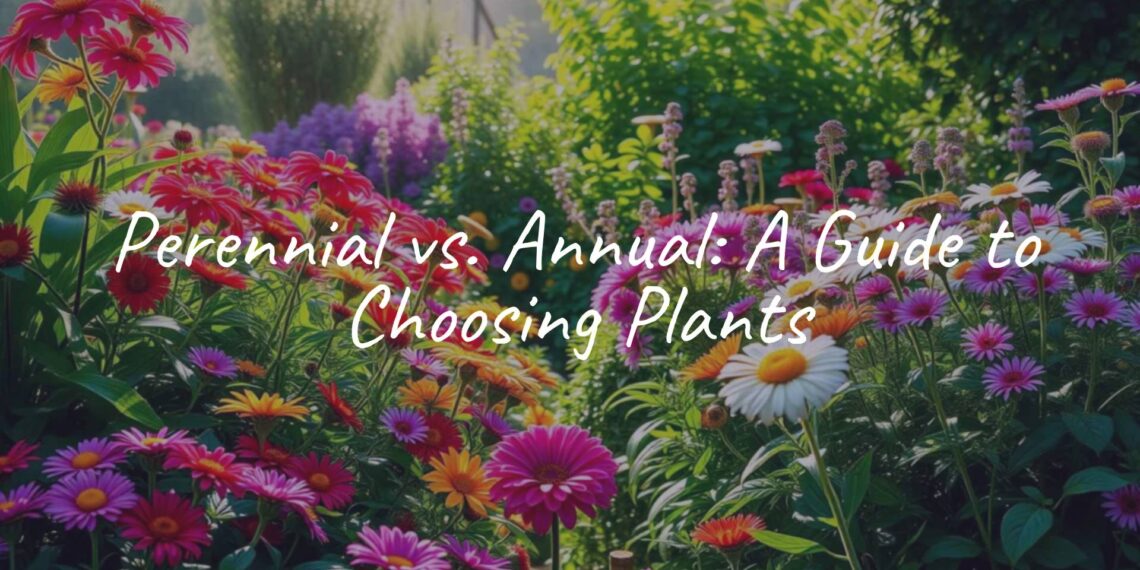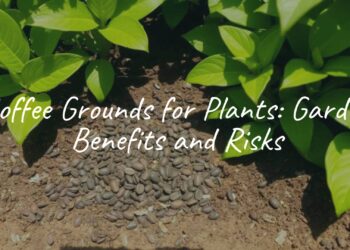Choosing between perennial and annual plants is an important decision for any gardener, affecting everything from how your garden looks to how much work you’ll need to do each year. The biggest difference between the two is their life spans: annuals grow, flower, set seed, and die all within one season, while perennials come back year after year. Knowing how these life cycles work will help you plan your garden and choose the right plants for your needs and style.

There isn’t a clear “better” option between annuals and perennials because both types are valuable for a well-rounded garden. Annuals lend bright, long-lasting color and the chance to change things up every year. Perennials add a steady background that keeps getting better with time. By learning about both, you can mix them effectively and enjoy a lively, attractive garden from the start of spring to the first cold snap.
How Are Perennial and Annual Plants Different?
One of the main things that shape a garden is the life cycle of the plants you choose. When we talk about annuals and perennials, we’re talking about how long a plant will live and what you can expect from it in your yard. This basic difference affects how you care for the plants and where they’ll fit best in your garden design.
All flowering plants go through stages like sprouting, growing, and setting seed, but how quickly this happens sets annuals and perennials apart. This is important to understand, as it helps you plan when to plant, how much money to spend, and what your garden will look like in the future.
Annuals: Main Features
Annuals are like the short-distance runners in the plant world-they start from seed in the spring, grow quickly, flower a lot, make seeds, and die when it gets cold. Because they only last one season (unless they spread their own seeds), you’ll need to plant them again each year if you want them to return.
Their short life means annuals put all their energy into flowers and seeds, so they give gardens lots of color over many months. If you like to refresh your garden or try new looks often, annuals are a great choice. Examples include petunias, marigolds, zinnias, and impatiens-plants well-known for strong, season-long blooms.

Perennials: Main Features
Perennials are more like long-distance runners. They live for at least three years and come back each spring. Some last only a few years, while others can stick around for decades. Because they stay for a long time, perennials are a great choice for those who want dependable plants in their garden.
Most garden perennials have stems and leaves that die back in the winter, but new ones grow from their roots each spring. Woody perennials, like shrubs and trees, keep their branches above ground all year. While perennials don’t usually flower as long as annuals, their leaves and shapes add beauty throughout the seasons. Daylilies, hostas, lavender, and peonies are favorite examples, getting bigger and better each year.

Comparison Table: Annuals, Perennials, and Biennials
To help make things even clearer, here’s a table that also includes biennials, which complete their cycle in two years:
| Feature | Annual | Perennial | Biennial |
|---|---|---|---|
| Life Span | One season | Three years or more | Two years |
| Return Each Year? | No (unless some seeds survive) | Yes | No (new seeds start new plants) |
| How Long Do They Bloom? | All season | A few weeks per year | Usually in the second year |
| Replanting Needed | Every year | No | Every other year or so |
| First Cost | Lower (seeds or small plants) | Higher (more mature plants) | Medium |
| Cost Over Time | More (because you buy each year) | Less (because plants return) | Medium |
| Care Needed | High (watering, feeding, deadheading) | Lower (after roots have settled) | Medium |
| Garden Flexibility | High (easy to change each year) | Low (lasts for years) | Medium |
| Examples | Petunia, Marigold, Zinnia | Daylily, Hosta, Peony | Foxglove, Hollyhock, Sweet William |

Types of Annuals and Perennials
There are many types of annuals and perennials, including sub-types based on how well they handle cold. This is helpful for figuring out which plants can grow in your area. Sometimes, a plant that acts as a perennial in one climate might be an annual in another if it can’t survive the winter.
Knowing about these differences will help you pick the right plants for your local weather and get the nicest, longest-lasting results.
Types of Annuals
Annuals fall into three basic types depending on their cold tolerance, which helps you know when to plant them:
Tender Annuals
Tender annuals are very sensitive to cold. They come from warm places and need hot weather to grow well. You should plant them after the last frost in spring. Examples: Begonia, Zinnia, and American Marigold.
Hardy Annuals
Hardy annuals can handle cool weather and sometimes even light frost. You can plant them earlier than tender types. Examples: Calendula, Pansy, and Sweet Alyssum.
Half-hardy Annuals
Half-hardy annuals are in between. They can take a little cold, but not as much as hardy annuals. They should be planted shortly before the last expected frost. Examples: Ageratum, Cosmos, and Petunia.
Types of Perennials
Perennials are also sorted by how much cold they can take:
Tender Perennials
These perennials can survive many years where it’s warm. If you live in a cold area, they must be protected or even brought indoors for winter. Many people grow them as annuals in these regions. Examples: Begonia (like Pegasus®), Black-eyed Susan (in cold areas), and Dahlia.
Hardy Perennials
True hardy perennials survive winter outdoors without special protection. They’re best for cooler climates. Examples: Aster, Blanket Flower, and Peony.
Half-hardy Perennials
These can handle mild frost but need some care-like extra mulch-in cold winters. They’re usually planted in spring after the last frost. Examples: Daylily, Hosta, and Coneflower.
Popular Annual and Perennial Plants
There are many beautiful annual and perennial plants for you to pick from. Some are bright and showy, while others have pretty leaves or interesting shapes. Here are some favorites in both categories:
Popular Annuals
- Petunias: Huge variety of colors and shapes; bloom from spring to frost.
- Marigolds: Bright orange, yellow, or red; easy to grow and helpful for vegetable gardens.
- Zinnias: Dazzling daisy-like flowers in many colors, great for cutting.
- Impatiens: Great for shade, available in pink, red, orange, purple, and white.
- Cosmos: Airy, daisy-shaped blooms that attract pollinators.
- Alyssum: Small, scented flowers; good for borders and containers.
- Coleus: Grown for colorful leaves in many patterns, perfect for adding style to shade gardens.
Popular Perennials
- Daylilies: Tough plants in many colors; each flower lasts a day, but the plant keeps blooming for weeks.
- Hostas: Loved for their bold leaves, with colors from green to blue to variegated patterns; ideal for shade.
- Lavender: Smells nice, has purple flowers, and attracts bees.
- Peonies: Big, beautiful flowers that can live for decades.
- Coneflowers (Echinacea): Purple, pink, white, or yellow daisy-like blooms that bring in butterflies.
- Black-Eyed Susans: Bright yellow flowers with dark centers; bring color late in the season.
- Sedum (Stonecrop): Succulent leaves and late-season flowers; needs little care.
- Phlox: Tall types for summer, groundcover types for spring; all with clusters of flowers.
Pros and Cons: Perennials vs Annuals
Picking annuals or perennials isn’t just about color. Each has its own benefits and drawbacks, which can impact how much work you need to do and how your garden looks as the seasons change.
Why Pick Annuals?
Annuals are great for people who want instant color and lots of options for changing things up. Here’s why you might like them:
Pros of Annuals
- Fast Results: Grow and flower quickly for instant color.
- Long Blooming: Most keep flowering from planting until frost.
- Lots of Choices: Huge range of colors, shapes, and sizes.
- Easy to Change: Switch styles each year; try new looks or colors.
- Fill Gaps: Perfect for spaces where perennials haven’t filled in yet.
- Affordable for Big Displays: Lower per-plant cost, especially if using seeds.
- Attract Pollinators: Some annuals bring in bees and butterflies.
Cons of Annuals
- Have to Replant: Need new plants or seeds each year.
- Need More Care: More watering, feeding, and deadheading.
- No Winter Interest: Beds are empty once they die off.
- Less Tough: Don’t handle drought or bad weather as well as perennials.
- Usually Smaller: Often don’t grow as big as perennials, so less dramatic structure.
Why Pick Perennials?
Perennials are good if you want a low-maintenance garden that grows stronger every year.
Pros of Perennials
- Saves Money with Time: Plant once and they come back each year.
- Strong, Established Look: Plants return bigger and better.
- Less Work Over Time: Less watering and feeding once they’ve settled in.
- Better for Soil: Deep roots help keep soil healthy and prevent erosion.
- Helps Wildlife: Many perennials support bees, butterflies, and birds.
- Adaptable: Suit their local area well, especially if you choose native kinds.
- Consistent Appearance: Don’t need to plan the whole garden from scratch every year.
Cons of Perennials
- Shorter Flower Time: Most only bloom for a few weeks; need to plant a variety for non-stop color.
- Take Time to Fill In: Might not bloom much the first year or two.
- Higher Beginning Cost: Larger or specialty plants can cost more at first.
- Less Flexibility: Harder to change your garden once established.
- Some Die Sooner: Not all are truly long-lived; some need dividing or replanting after a few years.
- Sometimes Need Dividing: To stay healthy, some perennials need to be split up as they spread.
- May Need Winter Care: Tender types could need extra mulch or protection in cold climates.
How to Care for Annuals and Perennials
Although annuals and perennials can both make your garden beautiful, their needs differ. Adjusting your watering, feeding, mulching, and trimming for each type matters if you want your plants to thrive.
Watering
Annuals have shallow roots and bloom for long periods, so they need frequent watering-about 1 to 1.5 inches each week. In hot months, daily watering may be needed, especially for containers. It’s best to water at the base, not on the leaves, to avoid disease.
Perennials get deep roots as they settle in, so once established, only need water about once or twice a week (about 1 inch total). Letting the soil dry a bit helps deepen roots and makes them tougher in dry spells.
Fertilizing
Annuals are heavy feeders since they grow and flower non-stop. Use slow-release fertilizer at planting and liquid feed every week during the season. Always follow package instructions.
Perennials don’t need much fertilizer once established. Overdoing it can give you lots of leaves, but few flowers. If your garden soil isn’t good, give a light feed in early spring. A soil test helps you figure out exactly what your plants need.
Mulching
A thick layer of mulch helps both types: it keeps soil moist, stops weeds, and keeps roots cool. For perennials, mulch is extra useful to protect roots in winter and steady soil moisture. Don’t pile mulch right up to the plant base or you could get rot.
Pruning and Deadheading
Annuals benefit from deadheading (removing old flowers) to keep blooms coming. Pruning back leggy stems keeps them full and bushy.
Perennial needs vary-a few need deadheading for more flowers, while others are best left alone until late fall or early spring, when you can trim old growth to make way for new. Woody perennials often need shaping. It’s smart to check what each specific plant needs.
Pest and Disease Care
Check plants regularly for trouble. Good airflow, careful watering, and not wetting leaves keeps disease away. If you spot bugs or disease, try safe methods like picking them off or using organic products. Healthy, well-cared-for plants deal with problems much more easily.

Which Should You Choose: Perennials or Annuals?
The question isn’t really about picking just one type. Most gardens look best and work easiest when you use both. Annuals bring bold color and change, while perennials create lasting structure and fill in more each year.
Think about your tastes, your budget, your climate, and how much gardening you want to do. The right mix will give you a thriving, attractive space each year.
Things to Think About When Choosing
- Your Gardening Style: Like changing things often? Annuals will suit you. Prefer a steady, easy-care garden? Go for perennials.
- Budget: Perennials cost more at first but save you money by coming back. Annuals are cheaper per plant but must be bought every time. A balance often works best.
- Time You Can Spend: Annuals need more regular care. Perennials usually need less attention after they’ve settled, but may need to be divided sometimes.
- Flowering and Color: For guaranteed color all season, annuals are best. If you enjoy watching a garden change from spring to fall, mix in lots of perennials.
- Space and Design Goals: Annuals are perfect for pots, boxes, or quickly filling empty spots. Perennials shape the look of your garden over years.
- Local Weather: Always match your plant choices to your climate and hardiness zone.
Impact on the Environment
As you think about your choices, keep in mind that in many cases, perennials are better for the environment:
- Soil and Erosion: Perennials, with their deep roots, hold soil in place and keep it healthy.
- Use of Water and Fertilizer: They often need less water and fertilizer once they’re established.
- Support for Wildlife: Native perennials often provide important resources for pollinators and other wildlife.
- Capturing Carbon: Long-lived plants help store carbon in their leaves, stems, and roots.
While annuals are beautiful, they often need more resources and have a higher impact from being grown, transported, and replaced every year. Still, when used mindfully, they’re a useful part of many gardens.
Design and Maintenance Preferences
- If You Want Quick Results: Annuals suit gardeners who like instant rewards and frequent changes.
- If You Want to Plant and Relax: Perennials are better if you want a garden that mostly takes care of itself.
- For the Best of Both: Most gardeners use both-perennials as the steady background, and annuals to add pops of color and change things up each year.
Choose what makes you happy. Experiment to find what works for your yard and your lifestyle.
Frequently Asked Questions: Perennial vs Annual
People often have practical questions about costs, environmental impact, and garden design when picking annuals and perennials. Here are some common answers:
Which Costs Less: Perennial or Annual?
In the short term, annuals are usually cheaper-especially if you start from seed. They give big color quickly at a low cost. But perennials come back year after year, meaning more value over time. You also might be able to divide them and get more plants for free. The smart move is to use both: get fast, affordable color from annuals, and lasting value from perennials.
Are Perennials More Eco-Friendly?
Generally, yes-especially if you use native types. Perennials improve soil, use less water over time, and help wildlife. They also keep carbon in the ground. Annuals can help too, but they require new resources each year, making perennials the more environmentally-friendly choice.
Should You Combine Annuals and Perennials?
Yes! Mixing both is one of the best ways to keep your garden looking full, colorful, and interesting all season. Here’s why:
- Nonstop Color: Perennials give you structure and return every year. Annuals fill in gaps and keep the garden in bloom even when perennials aren’t flowering.
- Design Variety: Use perennials as a main feature and annuals for fun, fresh changes or to try new color ideas.
- Fill Empty Spots: Annuals are great for covering spaces while perennials grow bigger.
- Better for Pollinators: A mix draws in more bees and butterflies, giving them food all through the season.
Combining both makes for a garden that looks good from spring through fall and is interesting year after year.
















![What to with Scrap Metal? [infographic]?](https://facts-homes.com/wp-content/uploads/2019/07/645413-POPYOV-391-120x86.jpg)





